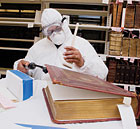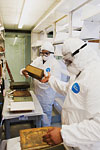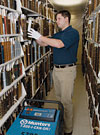
A
technician uses a nonmetal bound brush to remove mold spores from a book; a
HEPA vacuum prevents flaking. Once all the surfaces of a book had been cleaned,
it was placed on a fiber glass cart and carefully transferred into a transition
chamber.
The collection also is rich in first translations of scripture in Native American languages, including the first Bible printed in the New World (Eliot’s Indian Bible of 1663) and the only scripture ever published in the Delaware language, dating from 1818. With the mold outbreak, the rare book collection was in immediate jeopardy.
John Colligan, director of building management services for the society, recalled that stressful day last November when Dorothea Colligan, the library’s conservator, appeared at his office door, exclaiming, “We have a problem. We have mold!”
The mold, which mainly appeared on the surface of the Bibles, was the result of a defect in the second-floor HVAC system that raised humidity levels in the Rare Book Room. The moisture inside the room activated spores that are found in common dust particles.
“The Bibles require precise temperature and humidity control, and a failure of the ambient control system caused air to be improperly distributed throughout the entire room,” said John Colligan. “Thankfully, we caught the outbreak early enough so that mold growth was limited to the surface of the Bibles.”
DISASTER PLAN IN MOTION
The Bible society immediately activated its disaster recovery plan and contacted Paul Himmelstein, a conservator with a specialty in museum environmental control and collections management, and Munters Moisture Control Services (MCS) of Glendale Heights, Ill.John Colligan also contacted an environmental firm to test the air in the Rare Book Room. “My first concern was the safety of the staff,” he said. “We tested the air to determine if the mold situation was harmful to people. When we learned the air was safe, we immediately moved forward with the mold remediation plan.”
Himmelstein, an expert who often consults for museums and libraries, agreed to assist with the remediation project and to help devise the cleaning strategy. Joe Perko, an MCS account manager, was onsite to assess the situation the day after the society called.
Working together, Himmelstein and Perko developed a strategy to preserve the precious books. They devised a safe method of cleaning the Bibles that included the use of non-metal bound archival brushes, dehumidifiers, refrigeration equipment, and variable-speed HEPA vacuums, and also established remediation, transition, and containment areas.

After
a mold outbreak was discovered in the American Bible Society’s rare book
collection, Munters MCS oversaw the restoration of more than 1,100 volumes,
some dating to the 13th century. Restoration methods were skillfully used in
combination with state-of-the-art technology to end mold growth and then clean
away mold spores before re-shelving.
A PAINSTAKING PROJECT
Utilizing its state-of-the-art technology and restoration expertise, MCS adapted its standard mold remediation processes to follow the protocol requested by the conservator. Experienced document restoration experts from MCS soon arrived to handle the complex project.First, every book was tagged with a location number, and each shelf was marked with a numerical tag so that proper shelf locations could be maintained. A self-contained remediation area was constructed within the Rare Book Room. Inside the remediation area, variable-speed archival-grade HEPA vacuums and traditional air scrubbers removed the mold spores from the air, and dehumidifiers and refrigerants maintained temperatures between 69 and 72°F and relative humidity between 35 and 40 percent. Tables were set up for remediation of the individual books. MCS personnel used non-metal bound brushes to brush the mold spores off the outside of the books toward a HEPA vacuum to prevent flaking.
“Some of our Bibles are quite worn and fragile, so the remediation process was time consuming and difficult,” said Dorothea Colligan.
Once all surfaces of a book were cleaned, including the inside covers, it was carefully transferred into a transition chamber, a clean space that MCS constructed, and placed on a fiberglass car. After a final remediation in the transition chamber, MCS personnel from outside the transition area placed each Bible on another cart and wheeled it to a containment area constructed outside the Rare Book Room.
The containment area consisted of five rows of shelves encircled by 6-mil polyethylene plastic, traditional air scrubbers to clean the air, and a dehumidifier to control ambient conditions. Workers placed each Bible on a shelf corresponding to its original location in the Rare Book Room.
“We basically recreated the shelving in the containment area so that every Bible was put back in its original location,” Perko said. “This environment was monitored meticulously.”

Munters
MCS created temporary storage and processing facilities for the collection,
allowing restored volumes to be segregated from those still contaminated. Once
the collection was completely restored, Munters engineered and provided a
rental HVAC system to protect the volumes until a permanent climate control
system could be specified and installed.
ALL BOOKS RESTORED
The mold remediation project lasted four weeks.“It was a monumental and detailed task, and Munters was certainly up to the challenge,” said John Colligan. “Including them in our disaster recovery plan was a big benefit. This unfortunate event has allowed us to redesign the room and we are now selecting an HVAC system that is more appropriate for rare books.”
MCS equipment still controls ambient conditions inside the containment area while the old system is being replaced. All 4,700 rare volumes will eventually return to their original location inside the Rare Book Room.
“Munters was very efficient and adaptive at applying its standard process to the instructions of a consultant conservator,” said Dorothea Colligan. “They did a terrific job making sure all of the books were cleaned and safely returned in their original place.”
For more information, visit www.munters.com.
Publication date: 11/15/2010

Report Abusive Comment